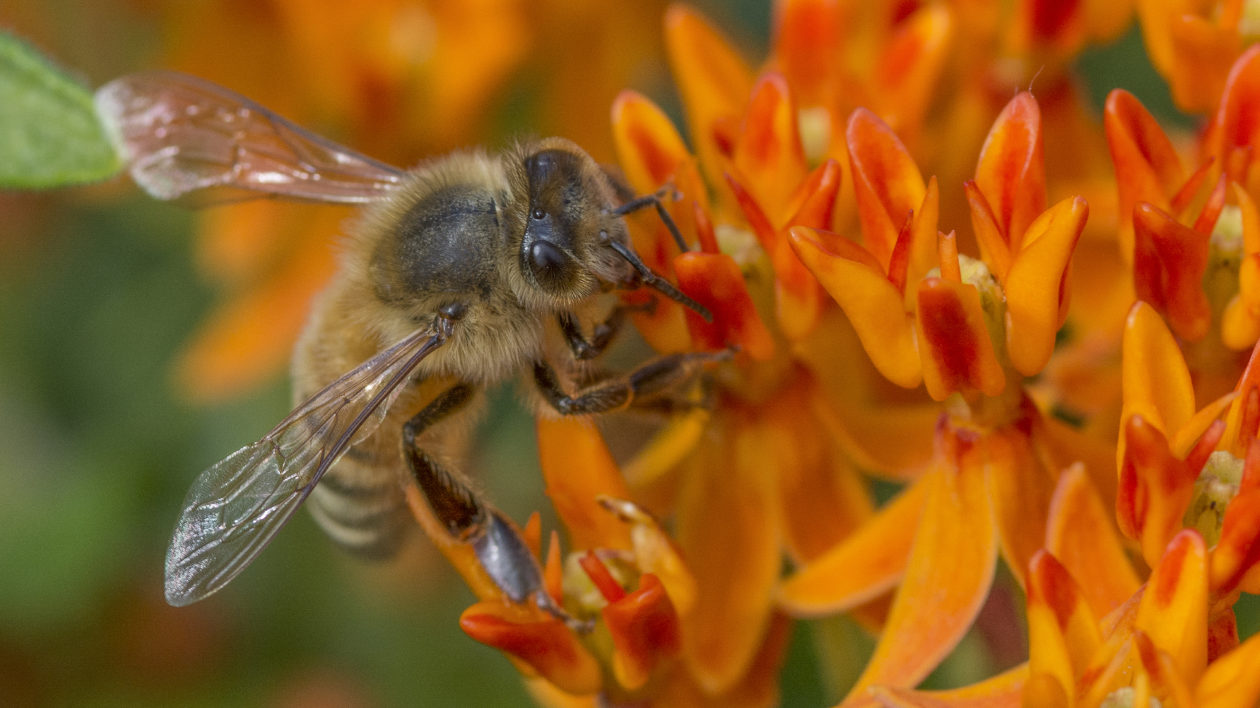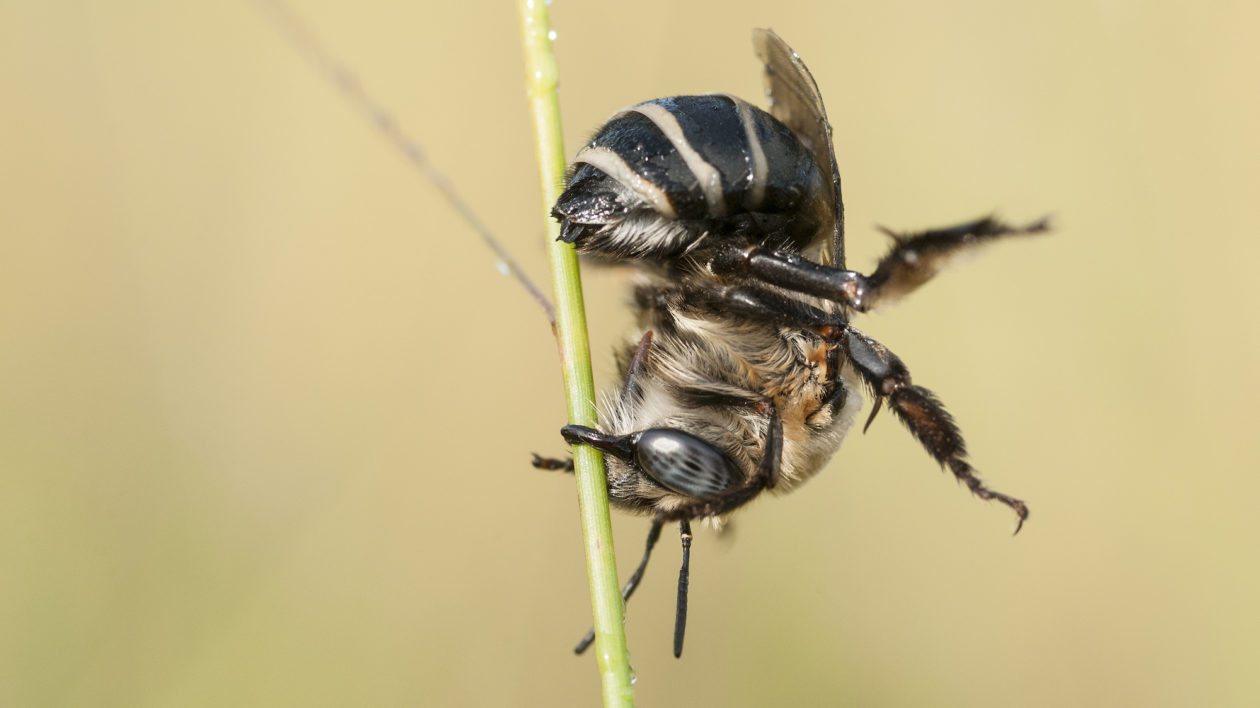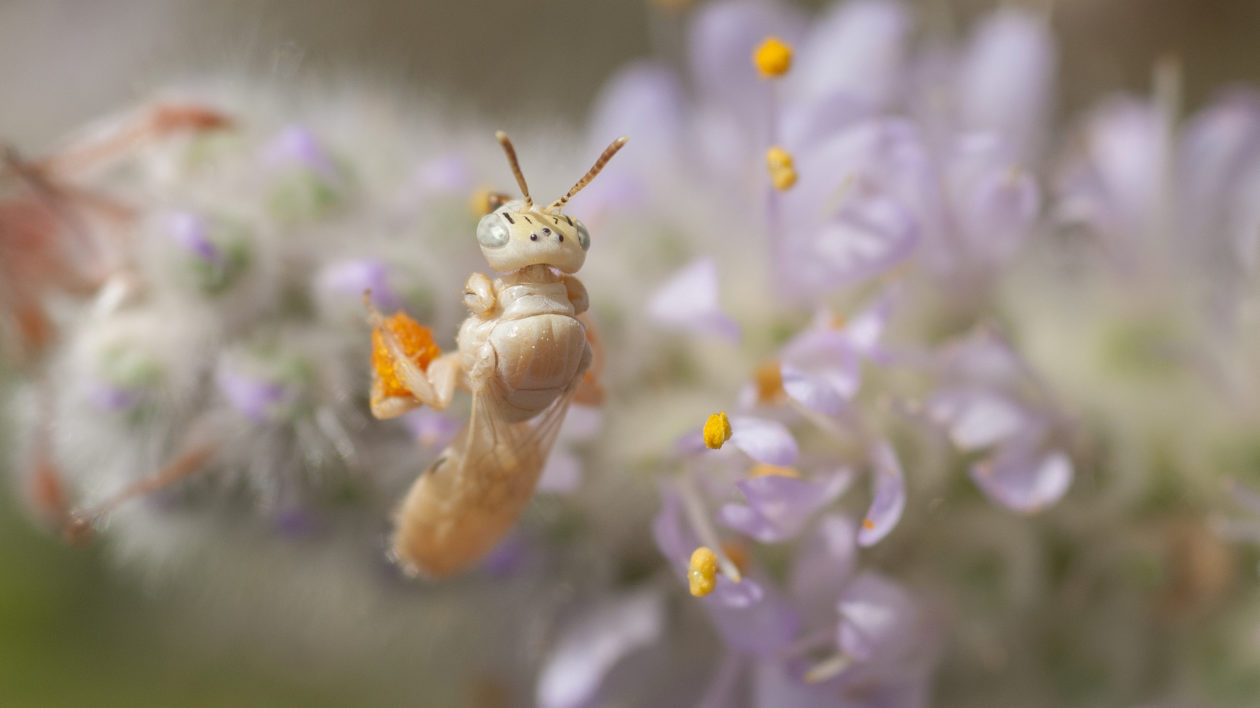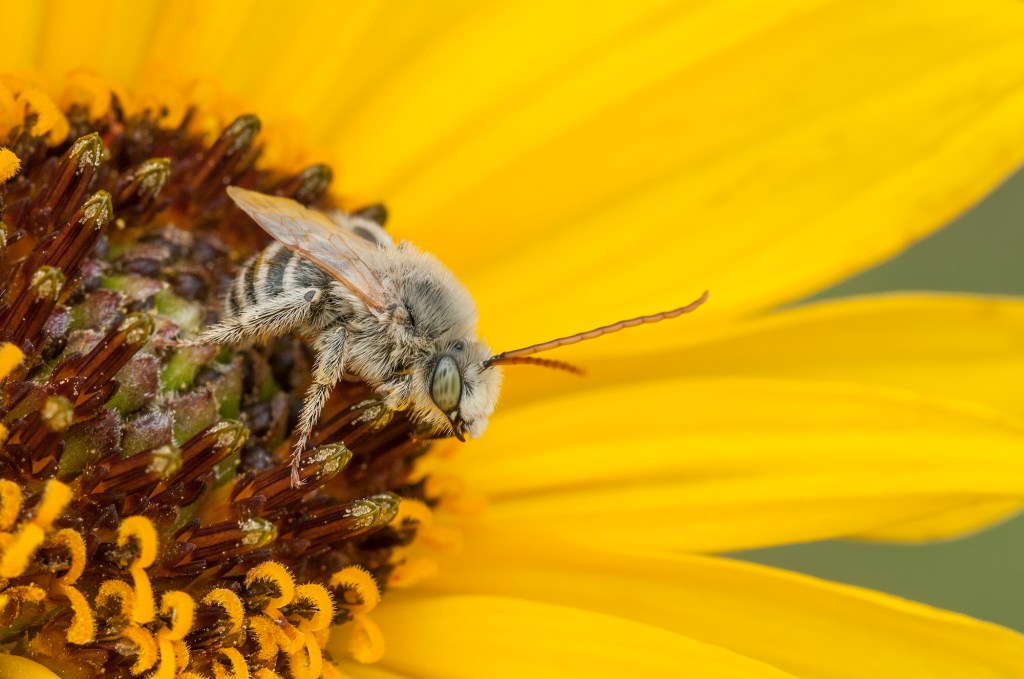The public is very aware that we are in the midst of a pollination crisis. In fact, concern about bees and other pollinators is nearly unanimous in public polling.
At a time when we are polarized on most issues, the need to do something about bees is something we can all agree on. Unfortunately, when people fret about bees and the threats they face, most are thinking about strictly about honey bees.
Honey bees are fascinating creatures. They’ve got an incredible social structure within their hives, they play important roles in the pollination of many food plants we like, and honey is delicious. However, honey bees are also an introduced livestock species in North America and only one of about 4,000 kinds of bees found in North America.
The thousands of native bee species living mostly below our collective radar are split into categories such as digger bees, carpenter bees, mason bees, sweat bees, bumble bees, and cuckoo bees.
The majority of those species don’t live in hives where workers cater to the needs of the queen and raise her babies for her. Instead, most native bees are reared in small nests built and tended by single mothers. Those female bees lay eggs, supply them with food, and protect them from enemies – all by themselves. A distinct minority of native bees live under some kind of cooperative system, and only a very few employ the kind of eusocial behavior we associate with honey bees.

The Dizzying Variety of Native Bees
Native bees also come in a dizzying array of colors, shapes, and feeding preferences. Bumble bees can be as large as your thumb, but many bee species are smaller than a grain of rice. Some are generalists that can feed opportunistically on whichever flowers are most abundant at the time.
Others are much more restricted in their diet, sometimes to a single species or group of species of wildflower. Plants, in turn, display a broad diversity of flower designs that can either make their nectar and pollen available to all comers or limited to only bees of a certain size, tongue length, or ability to vibrate flowers at a specific frequency.
Despite the astonishing variety among bees in North America, most conversations about bee conservation center on a single, largely agricultural species. Imagine if we did the same thing with birds — we’d be trying to raise more turkeys on farms out of concern for massive declines in overall bird populations.

To be clear, honey bees really are suffering declines. In fact, a recent report showed that around 38 percent of managed honey bee colonies in the U.S. were lost during the winter of 2018-19.
Honey bees are in no real danger of extinction, however, because humans are managing their populations. Native bees don’t have that kind of support system.
Honey bees also don’t cover the wide range of ecological roles played by our diverse native bee communities. The aforementioned variety of features and behaviors found within native bees means they can meet the needs of an incredible diversity of flowering plants. In contrast, honey bees provide pollination for a relatively small percentage of native flower species (estimates from around the world vary between 25 percent and 40 percent). In order to conserve the full species diversity and resilience of our ecosystems, we need our native bees.

The Fate of Native Bees
In addition to their inability to shoulder the entire load of pollination, there is also growing evidence that honey bees compete with and potentially contribute to the declines of native bees. That’s concerning, and it should make us thoughtful about how and where we place honey bee hives in and around natural areas. However, it’s also important to know that honey bees are not the primary reason our native bees are suffering.
In fact, honey bees and native bees share most of the same threats to their survival, with the loss of quality habitat topping that list. Similarly, many of the strategies to help save native bees will also help honey bees — and vice versa. We just need to be careful that saving honey bees aren’t the primary focus of conservation efforts or communications.
Increasing the size and quality of habitat for pollinators will boost populations of all bees, including both native bees and honey bees. Yes, certain pesticides and diseases are also causing major problems and we should continue to work on those issues as well.

However, adequate habitat quantity and quality greatly dampens the impacts of those other threats. We need to protect and restore plant diversity in natural areas and agricultural landscapes so that nectar and pollen resources are abundantly available throughout the year. In addition, we need to rebuild and reconnect floristically rich habitats wherever we can. Those are the only viable strategies to conserve bees of all kinds (and most of our native biodiversity).
Compared to those gargantuan tasks, changing the way we talk about bees seems pretty easy, but it is still really important. There are too many news stories that start with something like, “bees are suffering” and then proceed to talk only about honey bees.
Schools talk a lot about the social structure of honey bees, but don’t mention the majority of bees that don’t live that way. As a result, much of the public recognizes that we are experiencing a pollination catastrophe but thinks it’s an issue of bee keepers and their struggles to save their animals.
The real story of pollinators and their declines is much more compelling than the battle to save a livestock industry. The incredible variety among native bees, alone, can catch the public’s attention, especially when accompanied by photos showing the broad range of size, color, and shape among those bees.

People can also empathize easily with the extraordinary challenges facing single mom bees trying to feed and protect their progeny in a world of habitat fragmentation and degradation. Including butterflies, moths, flies, wasps and other insects in the discussion provides even more fascinating pollinator accounts and images.
The pollinator narrative is also easy to frame in ways that fit into the broader conservation context. Pollinators rely on habitat size, habitat connectivity, and plant diversity. Those are the key components of conservation success for most other species too, including our own.
Rebuilding and protecting the healthy and resilient landscapes bees need will provide for the needs of both nature and people. That’s a story we should be telling.

The public already cares about pollinators; we just need to be smarter about how we talk about them. If we’re successful, we’ll save much more than just bees. We can start by fixing our myopic focus on honey bees.
Turkeys are impressive and interesting creatures, but we’d never choose them as the primary focus of our bird conservation communications and strategies. Why, then, are we following that pattern for bees?
Let’s celebrate the incredible diversity of our native bee and pollinator communities and be more creative in the ways we engage the public on the topic of pollinator conservation. With 4,000 bee species in North America, along with countless other species of pollinators, it’s not like we’re short on material.




I have a good-sized native Greater lobelia here in Michigan. It has about 20 blossoms on it right now. There are two bees feeding on it almost continually. The bees look like Bumble bees but they are smaller than the ones I normally see. Are they juveniles or a different species?
Thanks so much for this article! I got to be part of a study counting pollinators and beneficial insects here (my tiny retiring farm on the mostly dry New Mexico prairie) this summer, counting four quadrats and two transects every other week. I thought I knew my insects, but I’d never seen most of the tiny native bees I got to count. I was stunned at how many different species I saw (with the help of a loaned pair of close-focus glasses), and learned which flowers drew which bees, and syrphid flies, and a full complement of various wasps as well. Though some honey bees showed up in June when more flowers were blooming, they disappeared by July, leaving the field to the natives, which may not be evident if plants cease flowering in a dry spell, but the bees are back after a little rain, and they are still at it in late August. I have come to love them, and I no longer worry that dwindling honey bees will mean disaster for our plants, at least here where routine agriculture is difficult. We have our little friends…
Well, thats an article that needed to be written! We all hear about honey bees & their vulnerability, but I didnt know they are not native bees! Nor that all bees dont live exactly the same way. Single mothers, huh?
Will have to investigate more native flowering plants now.
Sadly, not only have I seen only a couple single butterflies but very few bees – other than the huge ones that may be carpenter or bumbles.
Great information as always
Would it be possible to distribute photographs of native bees in their habitats to the interested public? Since the majority of the general public are unaware of native bees spreading the message of their needs and ways to assist them might encourage citizens to address the problems native bees face. The photographs in this article are enchanting and could be the jump start that is needed to include more people. It has been written that a picture is worth a thousand words. What if this information were more widely known in places where the public could become involved. There are efforts to incorporate farmers and ranchers to promote native pollinators, what about including suburban and urban citizens? Are there efforts to include the backyard gardeners in this effort? My first thought would be Master Gardeners at local Agricultural Extension Offices and at garden centers. Any input?
This is so true! I am a beekeeper, increasingly frustrated and discouraged with everything my honeybees are up against and yet I also understand it’s not only about honeybees. I’ve made the decision that this will be my last year of beekeeping if my bees, once again, dint make through the winter. Instead, I plan to put my resources into enhancing my property with native plants so it will encourage ALL pollinators. It takes a village … one garden at a time.
Great photos and texts. I am amazed that you captured that Perdita. It’s hard to get people even to appreciate native bees. I am particularly interested in these that are specific plant visitors. thanks.
I believe that wildflowers are the only hope for the bees. Meanwhile, we have declared a war on wildflowers. The highways and farm to market roads are over mowed during peak wildflower blooming season. In North Texas, our bluebonnet season was a big disappointment. Ladybird Johnson, who pioneered the planting of wildflowers along our highways, would be livid!
Important information. Tell me more!
Wonderful! Thank you so much for writing this! I will definitely share. I live in SoCal and have a robust native plant garden. I’m on a recent quest to ID all the wildlife visiting my garden and have dicovered a wide variety of native bee species and shared these with iNaturalist (kriseth7) and post photos of native bees on FB groups, garden groups, to advocate for native plant landscapes and native wildlife and pollinators. People are becoming very engaged and expanding their knowledge with new vocabulary. People interested in supporting regional bee species should seek out their native plant societies and garden clubs. Native plants have evolved along with native insects! The difference is remarkable. Plant native!
Chris – I follow your blog and always enjoy your amazing photography and your passion for prairie habitats. The city of Greeley, CO manages about 1000 acres of primarily suburban “natural areas”. We strive to manage these areas to the benefit of all our wildlife species, including native pollinators. Our struggle is getting neighbors to understand that these are not weed-infested sites that should be mowed short throughout the growing season – e.g. treating them the same as an irrigated, manicured park devoid of habitat. But we stay strong and continually convey the message that it is our social responsibility to provide and protect these habitat areas to the benefit of those species that rely on them as their home, grocery store and gathering spaces. Keep sharing your insights and passion – they help me stay positive and find new ways to re-educate our public.
While our family hobby is honey bee keeping , we also have large flower gardens as well as a vegetable garden. We have noticed an increase in all the natural wildflowers and with that an increase in the number of native bees, hornets and wasps.
Our friends and neighbours have developed an interest in bees and have discontinued their habits of setting out traps for hornets and wasp as well they have lessened their lawn mowing and taken a interest in planting bee friendly plants.
I live in newfoundland. One of the last places in North America where bees can bee raised relatively disease and pest free.
I hope that my hobby will in some small may encourage and educate others about the importance of preserving all our habitats and the wonders in it.
We live in a coastal California forest. In my large property I grow as many native species of flowering plants as possible. I’ll be out working among Pride of Madera, for example, and enjoy hearing the bees buzzing all around me in the dense purple spires of flowers. I’ve seen several types of bees, including honey bees of course. The only time I was stung was entirely by accident. And not in my garden but on the beach as I was raising my hand to wave at a friend and a poor bee got caught in the action. I have to admit to hurt more than I imagined it would, but it didn’t make me afraid or stop me from working among them in the yard.
Well I certainly did not know that not all bees are black and yellow. We definitely need more education so they are not mistaken for an odd type of fly or wasp.
Great article. Thank you
I have been an advocate of native bees for sometime. I always try to point out to people that honey bees are alien to this continent and our native bees are just as important to pollination than are honey bees, even more so. In my garden I use no “cides” and let native plants flourish. I often take photos of native bees and post them on my FB page. I understand that all our pollinators are in danger from humans and habitat loss. I belong to the Xerces Society and contribute to their organization. I hope for more awareness of all our pollinators, not just honey bees. I have a wild hive on my property that arrived two years ago. The person who lives on the property across the road has hives and raises queen bees. I assume they came from there. I leave them alone and they made it through one winter. Only time will tell if they will survive.